Etching
Etching
allows spontaneity and informality in drawing
on the plate and consequently it is the
technique most closely associated with
artists’ original printmaking; and
that with the longest continuous history.
Developed
originally as a means of armourers’ decoration,
etching was adapted as a pictorial printing
technique in the early years of the 16th
century. Perhaps because of this early
association with armour, the first German
exponents, Dürer, Hirschvogel, Lautensack,
Amman and the Hopfers used iron plates,
which gave a coarser, more uneven line,
than the now traditional copper. Lucas
Van Leyden in the Netherlands and Parmigiano,
the first etcher of note in Italy, however
employed copper for their plates. Copper
prevails to this day, though in the 20th
century zinc has also been used as a cheaper
alternative, especially for very large
plates, by artists such as Frank Brangwyn.
The
word ‘etching’ has its roots
in the old High German ezzen “to
eat”, for traditionally the drawing
is eaten (‘bitten’ in modern
parlance) into the copper plate by acid.
The etching acid is known as the ‘mordant’ (from
the French mordre “to bite”).
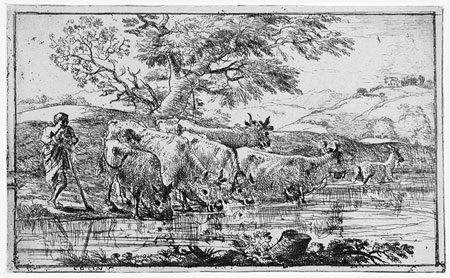
Claude
Gelee (known as ‘Claude’ or
Claude Lorrain) (1600-1682):
“The
Herd at the Watering Place”. Etching,
c1635-60. (107 x 174 mm)
The
artist lays a dark ground onto the copper
plate, covering and sealing its surface.
A ball of solid ground, composed of mixed
waxes, resins and gums, is applied to the
heated plate so that it melts and spreads
easily. In previous centuries the ground
did not come ready coloured, but was darkened
by holding the prepared plate over a lighted
taper (see right) whose smoke was absorbed
by the ground and turned it black. The
ground sets hard as soon as the plate is
cold. The dark colour enables the artist
to see the marks of the etching needle
as he draws through the ground and exposes
the copper beneath.
When
immersed in nitric acid (or hydrochloric
acid mixed with chlorate of potash – the
Dutch bath) the exposed copper reacts with
the acid which chemically cuts the drawing
into the plate. In earlier times the plate
was bitten by building low wax walls around
the perimeter and pouring the acid over;
today it is placed in a small ‘bath’ of
acid. The longer the plate is exposed to
the acid the deeper will the lines be etched,
the more ink they will hold and the heavier
and thicker will be the resulting printed
line. Variety of tone, almost amounting
to colour, can be achieved by controlling
the degree of etching of different areas
of the plate.
Stop-out
varnish is applied to lightly bitten areas
to protect them if the plate is further
immersed to strengthen bolder areas of the
design.
‘Trial
proofs’ may be printed at different
stages of the plate’s progress so
the artist can see how his print is developing. ‘Counterproofs’ (see
below right),
which reverse the image, are sometimes
printed by passing a freshly printed impression
back through the press to print on to a
new sheet of paper. The counterproof is
in the same direction as the work on the
plate and the artist can experiment with
amendments by drawing or painting on top
of the counterproof as a guide to how he
should proceed on the plate. Artists also
sometimes make these sort of amendments
to trial proof impressions, which are known
as ‘touched proofs’.
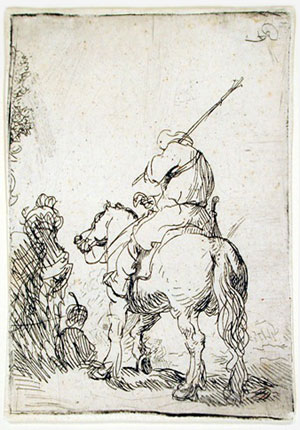
Rembrandt
Harmensz. van Rijn (1606-1669)
“The Turbaned Soldier on Horseback”
Etching, c1632. (83 x 58 mm)
Only
isolated experiments with etching were
made in the 16th century but the following
century it flowered as artists became aware
of the expressive possibilities of its
flowing eloquent line. The 17th century
was indeed a golden age of etching. Many
of the greatest painters of the period,
and particularly the generation active
1625-45, were enthusiastic etchers; Rembrandt
and Ostade in Holland; Reni and Castiglione
as well as the Spanish Ribera and French
Claude in Italy. For Jacques Callot, Stefano
della Bella, Abraham Bosse and Wenceslaus
Hollar it was their principle form of expression.
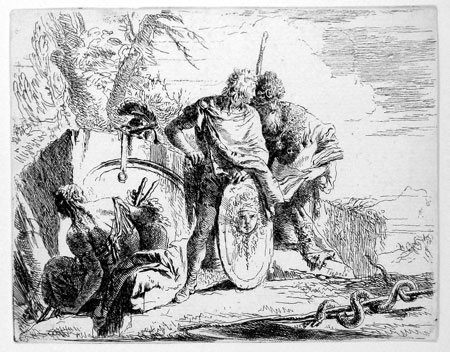
Giovanni
Battista Tiepolo (1697–1770): "An
Astrologer with a young Soldier".
Etching, c1740. (one of the ‘Vari Capricci’ series). (134
x 170 mm)
In
the 18th century in England, France, and
Holland printmaking became largely concerned
with reproduction, utilising other printmaking
techniques, but in Italy Canaletto, Tiepolo
and Piranesi continued the tradition of
original etching.
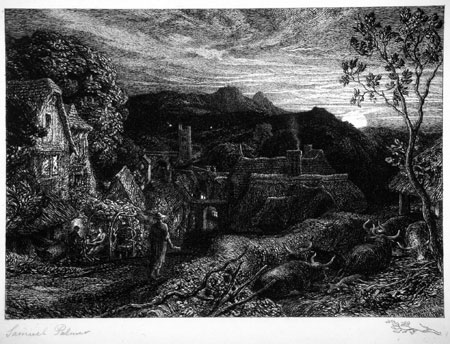
Samuel
Palmer (1805–1881): "The Bellman". Etching,
1879.
A ‘remarque’ proof – see
the small branch etched into the lower
border of the plate. (190 x 251 mm)
The ‘Etching
Revival’ in the 19th century was
initiated in Britain by the artists of
the Norwich School and in France by Daubigny
and the artists of the Lyon and Barbizon
schools, all of whom were inspired to follow
the example of the great Dutch masters
of the 17th century. The founding of etching
clubs and the societies of Painter-Etchers
gave a broader base of popularity and by
the end of the century etching was once
again practised widely as an original expression
by artists.
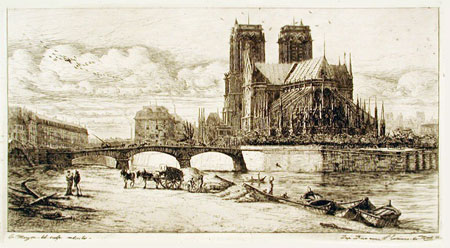
Charles
Meryon (1821-1868): “L’Abside
de Notre Dame”. Etching, 1854
(one of Meryon’s series of ‘Eaux-fortes
sur Paris’). (163 x 298 mm)
Paris,
as the artistic centre of Europe, had a
seminal influence in exposing artists from
all over Europe and America to original
printmaking. The
various art journals illustrated with original
impressions of etchings further promoted
the technique internationally.
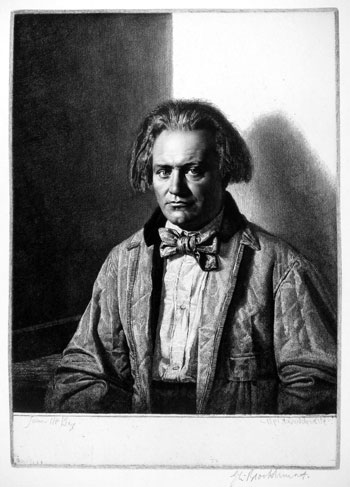
Gerald
Lesley Brockhurst (1890–1978):
"Portrait of James McBey".
Etching, 1931. (267 x 190 mm)
Brockhurst was a superb technician
and none of his peers could
do such fine needling
or create such density of tone and texture.
By
the early decades of the 20th century there
was an ‘Etching
Boom’ in England and a thriving international
market supported by the Print Collectors’ Clubs
which only collapsed with the Depression.
Etching
lends itself to two stylistic approaches
which can be recognized throughout its
history, the calligraphic open linear style,
combined with expressive ‘blank’ areas
of paper and the tonal method of cross
hatching with sometimes scarcely a glimmer
of paper showing through the closely worked
mesh of lines. Compare the etchings
above by Claude, Rembrandt and Boreel
with the Palmer and Brockhurst.
Artists
also frequently mixed etching with other
intaglio techniques, engraving, drypoint or aquatint. |